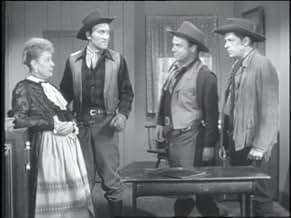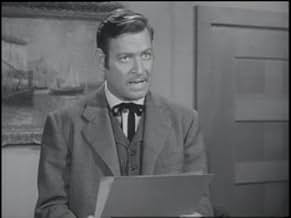Ajouter une intrigue dans votre langueThe adventures of the masked Texas Ranger and his Native American partner.The adventures of the masked Texas Ranger and his Native American partner.The adventures of the masked Texas Ranger and his Native American partner.
- Nommé pour 2 Primetime Emmys
- 3 nominations au total
Avis à la une
There can be no denying that The Lone Ranger is the quintessential TV Western of the 1950s. It is the one show that has proved, time and again, to be a real favorite of both children and adults alike.
Starring Clayton Moore, as the masked rider, and Jay Silverheels, as Tonto, his ever-loyal sidekick, The Lone Ranger was an action-packed, half-hour program whose episodes always had an interesting and thoughtful story to tell about life in the days of the Old West.
Actor Clayton Moore was the absolute embodiment of this mysterious, masked crime-fighter who would often go to great lengths to see that justice was done and that the criminals paid a dear price for their dishonest deeds.
Clayton Moore was once quoted as saying that he had "fallen in love with being the Lone Ranger character".
The Lone Ranger's story concerns a nameless Texas Ranger who is the sole survivor of a vicious ambush. After he is nursed back to health by his new-found comrade, Tonto, he embarks on a mission to bring justice and peace to the lawlessness of the Old West.
Using the benefits from a secret silver mine, the Lone Ranger rides the West on his magnificent horse, Silver, and dispenses justice in the form of his trademark - The silver bullet.
Following the cancellation of The Lone Ranger in 1957, Clayton Moore then embarked on a 40-year career making personal appearances, TV guest spots, and classic TV commercials dressed up as the legendary masked man.
In 1999 Moore died of a heart attack. He was 85 years old.
I suspect that most people reading this will have at least some knowledge of this series, but I'll give a brief synopsis of it anyway. A group of six Texas Rangers go riding after an outlaw gang (the Cavendish Gang). The Rangers are being led into a trap by a scout who is working for the gang and five of them are killed in an ambush. The sixth, a man named Reid, survives, in no small part due to the help of an Indian named Tonto who, in a twist of an improbable nature, met him once before, when Tonto was a boy. Reid helped him then and he returns the favor, calling Reid "Kemo Sabe".
Reid recovers and decides to take up a secret identity to track down and bring to justice bad guys. He dons a black mask and a white hat, calling himself "The Lone Ranger". He saves and then tames a wild white stallion he calls Silver. Having a secret silver mine, he covers his expenses and manufactures silver bullets from the ore taken from the mine. Thus is a hero born.
Clayton Moore played the title character most of the series, though John Hart assumed the role for 52 episodes after the first 78 were produced. When Hart wasn't accepted as the character by audiences, Moore returned. Jay Silverheels played Tonto for the entire run, appearing in virtually every episode. Lots of recognizable faces appeared in the series, most of them before they became famous, like DeForrest Kelly, pre-Star Trek and Victor Sen Yung, pre-Bonanza.
This series is available on DVD, most notably the Classic Media The Lone Ranger: Collector's Edition, a 30 disc release containing all 221 episodes. The set is excellent and well worth having if you're a fan. Recommended.
Most of the credit for the show's success goes to its leads, Clayton Moore and Jay Silverheels. They became the Lone Ranger and Tonto, lived the roles as no other actors before or since. Moore, in particular, knew the Ranger was presented as a hero and an example to children, and from what I've heard, he tried his best to live up to that. He made the Ranger a fair and just man, someone who didn't judge, who gave people the benefit of the doubt, but acted correctly when the time was right. He used violence only as a last resort. He was a symbol of honor and integrity, the kind of person I wish I could be.
As for Tonto... It occurs to me nowadays how great an actor Jay Silverheels was. Critics of the show always want to use Tonto as the stereotypical ignorant savage, but you have to look at all the things Tonto does. Tonto tracks, takes care of the Ranger when he's wounded, spies out information - you can tell from the expressions on Silverheels' face that there's a lot more going on inside Tonto's head than he lets on. Don't let the broken English fool you!
The thing that really impresses me about `The Lone Ranger' now is how much of a partnership these two characters have. Tonto is not the Ranger's subordinate - they are friends, equals in their adventures. That, as much as any lesson taught in any episode, is what draws me back to the series after so many years: a tried and true friendship.
Oh, if only the Lone Ranger could ride again.
Le saviez-vous
- AnecdotesThe Lone Ranger's young nephew, Dan Reid, who appeared occasionally on this show, was the father of Britt Reid, The Green Hornet. Both characters were created for radio by George W. Trendle.
- GaffesWhenever the Lone Ranger is seen putting on his mask, he secures it by tying it around the back of his head. During times when he loses his hat, say in a fight, it can be seen that the mask is secured with an elastic band.
- Citations
[first lines for each episode]
Narrator: The Lone Ranger!
[gunshots are fired]
The Lone Ranger: Hi-yo, Silver!
Narrator: A fiery horse with the speed of light, a cloud of dust and a hearty "Hi-yo Silver" - the Lone Ranger!
The Lone Ranger: Hi-yo, Silver, away!
Narrator: With his faithful Indian companion, Tonto, the daring and resourceful masked rider of the plains led the fight for law and order in the early West. Return with us now to those thrilling days of yesteryear. The Lone Ranger rides again!
- Versions alternativesThe first three episodes are available edited together as a ersatz feature "Enter the Lone Ranger" (1949) running 68 minutes minus titles and recaps.
- ConnexionsEdited into The Legend of the Lone Ranger (1952)
- Bandes originalesWilliam Tell Overture: Finale
(uncredited)
Written by Gioachino Rossini
[Played at program opening and during closing credits]
Meilleurs choix
- How many seasons does The Lone Ranger have?Alimenté par Alexa
Détails
- Date de sortie
- Pays d’origine
- Langue
- Aussi connu sous le nom de
- El llanero solitario
- Lieux de tournage
- Sociétés de production
- Voir plus de crédits d'entreprise sur IMDbPro
- Durée30 minutes
- Rapport de forme
- 1.33 : 1






































